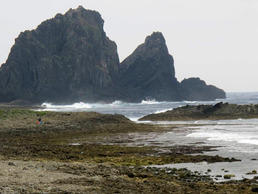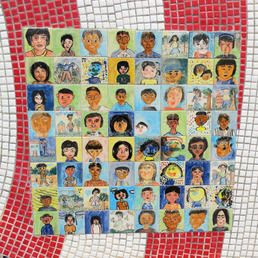Information on our work among the Tao
Lanyu's east coast
Image Credit: Leberecht Funk
Colored tiles at Lanyu's Junior High School
Image Credit: Leberecht Funk
The Tao on the Taiwanese island of Lanyu
The Tao, also known as Yami in ethnographical literature, belong together with the Minangkabau and Bara to the West Austronesian language family. Large differences, however, exist between these groups in terms of the structural aspects of socialization. Their mountainous island is situated about 40 nautical miles from the southeast coast of Taiwan, settlement is only possible along a narrow coastal strip. The Tao are small in number, totalling to just around 3000 people which are distributed into six villages. The main source of living is horticulture and fishery, the latter holding a continuous significant ritual value. Today the majority of the Tao people have converted to Christianity, perceived as providing a protective shield keeping the formerly dreaded evil ghosts at bay.
The ancestors of the Tao came from the Northern Philippine Batan Islands some 800 years ago to settle on Lanyu. Even today, strong linguistic and cultural similarities remain between these two groups. It was not until the 1960s that the Island of Lanyu became accessible to the outer world. This can be considered as one of the main reasons why the Tao succeeded in preserving their culture much better than other groups of indigenous people in Taiwan.
The nuclear family plays a dominant role in the social organization of the Tao, thus distinguishing them from the Minangkabau and Bara where the extended family is most important. Political office and social rank are unknown to the Tao, and social interaction has an egalitarian character. Although weak patrilineages can be observed, the structure of kinship is essentially bilateral.
Today, many Tao work in Taiwan mainland (mostly as unskilled labourers) as a result of virtually no job opportunities on Lanyu. In spite of growing significance of the monetary economy, the Tao have retained their traditional mode of subsistence; staple foods like taro and fish are still not purchasable on the market. In all villages where schools are situated, the medium of teaching is Mandarin Chinese. Most children are not able to communicate in their indigenous language anymore.
In Taiwan the Tao take an exceptional position because they are the only indigenous group living in a completely maritime environment. Contrary to the mountain tribes which still practiced head-hunting during the Japanese colonial rule (1895-1945), the Tao have been described as a people avoiding aggressive behavior.
Fieldwork among the Tao will be conducted from October 2010. Besides gaining access to emotional concepts through language, special attention is also given to the Tao’s expressional reactions and expressional signs of the body. On the level of physical expression, even those emotional qualities which lack analogy in the respective language can be captured and separated from each other. By composing a lexicon of expression, the following questions with regard to cultural comparison will be discussed:
- Do the same expression signs appear in different cultures?
- Do they have the same meaning and function?
- Do they point to comparable emotional concepts?

